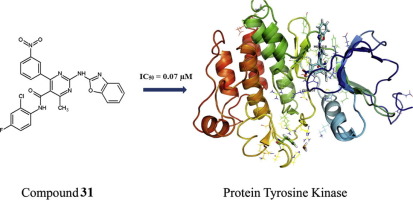Bioorganic Chemistry ( IF 4.5 ) Pub Date : 2018-01-04 , DOI: 10.1016/j.bioorg.2018.01.008 Rupesh Chikhale , Sonali Thorat , Rajan Kumar Choudhary , Nikhil Gadewal , Pramod Khedekar

|
Abnormal signalling from the Protein tyrosine kinases (PTKs) like receptor tyrosine kinases and intracellular tyrosine kinases can lead to diseases such as cancer especially non-small cell lung cancer, chronic myeloid leukaemia and gastrointestinal stromal tumours. Various Protein tyrosine kinase inhibitors are available but face poor bioavailability, severe toxicities and recent cases of drug-resistant cancers prompts for development of better drug molecules. In this study we report the design and development of a novel Protein Tyrosine Kinase (PTK) inhibitor on the basis of pharmacophore modelling. Compound 2-(benzo[d]oxazol-2-ylamino)-N-(2-chloro-4-fluorophenyl)-4-methyl-6-(3-nitrophenyl) pyrimidine-5-carboxamide 31 was obtained containing essential pharmacophore structural features. This compound exhibited highest activity against leukaemia cell line (RPMI-8226) at 0.7244 µM, renal cancer cell line (A498) at 0.8511 µM and prostate cancer cell line (PC-3) at 0.7932 µM on the NCI five dose assay test. The PTK assay provides promising activity at IC50 of 0.07 µM in the human breast cancer cell line MDA-MB-468. Compound 31 had good intermolecular interaction with PTK in the molecular docking studies, this ligand-enzyme complex was found to stable in the MM-PBSA study over 100 ns. It had 54.22% oral bioavailability with Tmax of 0.60 h which is higher compared to the dasatinib with bioavailability and Tmax of 14–34% and 1–1.42 h respectively. Anticancer action of 31 was found to be impressive in pharmacokinetic studies making it a potential lead molecule.
中文翻译:

新型氨基苯甲酰嘧啶酪氨酸激酶抑制剂的设计,合成及抗癌研究
蛋白酪氨酸激酶(PTK)像受体酪氨酸激酶和细胞内酪氨酸激酶的异常信号传导会导致疾病,例如癌症,特别是非小细胞肺癌,慢性粒细胞白血病和胃肠道间质瘤。可以使用各种蛋白酪氨酸激酶抑制剂,但它们的生物利用度差,毒性严重,并且最近的耐药性癌症病例促使人们开发出更好的药物分子。在这项研究中,我们报告了基于药效基团建模的新型蛋白酪氨酸激酶(PTK)抑制剂的设计和开发。化合物2-(苯并[ d ]恶唑-2-基氨基)-N-(2-氯-4-氟苯基)-4-甲基-6-(3-硝基苯基)嘧啶-5-羧酰胺31获得含有必需药效团结构特征的化合物。在NCI五剂量试验中,该化合物对白血病细胞系(RPMI-8226)的活性最高,为0.7244 µM,对肾癌细胞系(A498)的浓度为0.8511 µM,对前列腺癌细胞系(PC-3)的活性最高,为0.7932 µM。PTK分析在人乳腺癌细胞系MDA-MB-468中的IC 50为0.07 µM,提供了有希望的活性。在分子对接研究中,化合物31与PTK具有良好的分子间相互作用,在MM-PBSA研究中,该配体-酶复合物在100 ns内稳定。它的口服生物利用度为54.22%,T max为0.60 h,高于达沙替尼的口服生物利用度和T max分别为14–34%和1–1.42 h。在药代动力学研究中发现31的抗癌作用令人印象深刻,使其成为潜在的先导分子。











































 京公网安备 11010802027423号
京公网安备 11010802027423号